Are you wondering how much you can make as a freelance writer? It can be hard to figure out as estimates vary widely. Indeed says writers average $22 per hour while headlines say you can make hundreds of thousands per year.
In an effort to find out what’s really going on, we asked 346 freelance writers from 31 countries about their income and rates.
After crunching all the numbers, we’re excited to share some interesting insights! Read on to learn how much writers are earning, how they’re charging, and what tends to lead to higher incomes.
(A big thank you to all who participated in the survey and made these insights possible!!)
Table of Contents
Short on time and want to skip ahead? No problem — here’s a quick overview of what the report includes (with jump links).
- Average income of freelance writers
- Charging methods and income impact
- Outsourcing work and income impact
- Niches and income impact
- Payment schedules and income impact
- Hours worked per week and income impact
- Years of experience and income impact
- Number of clients and income impact
- About the survey
- Shareable stats
How Much Do Freelance Writers Make Per Month?

To get started, let’s look at how much freelance writers are making per month. It can vary greatly from a couple hundred bucks, up to $15k or more.
Here’s a more detailed breakdown.
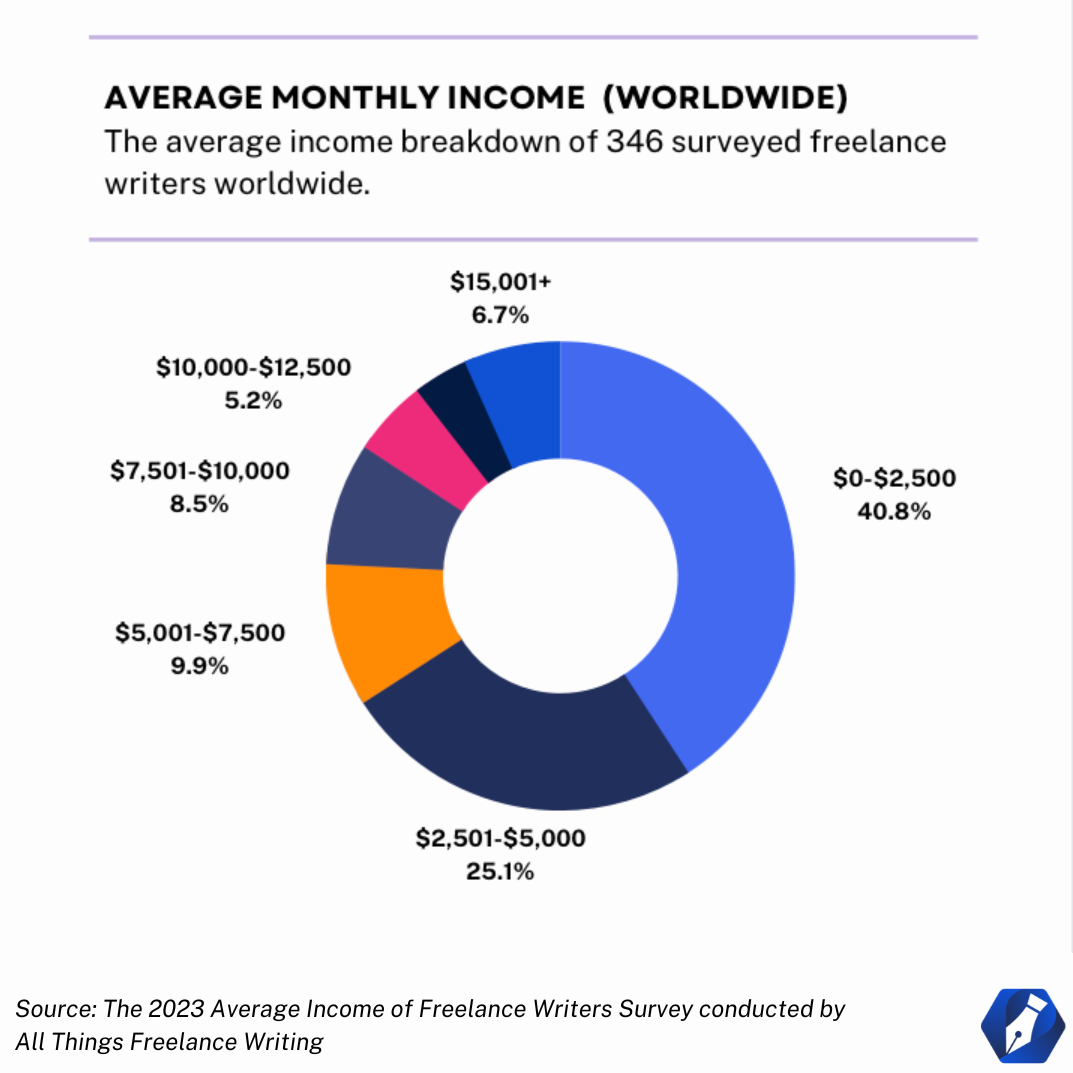
The majority (65.9%) of freelance writers we surveyed said they make $5,000 or less per month. Of the writers who make more than $5,000, 18.4% make from $5,001 to $10,000 per month, and 15.7% make $10,001 or more per month.
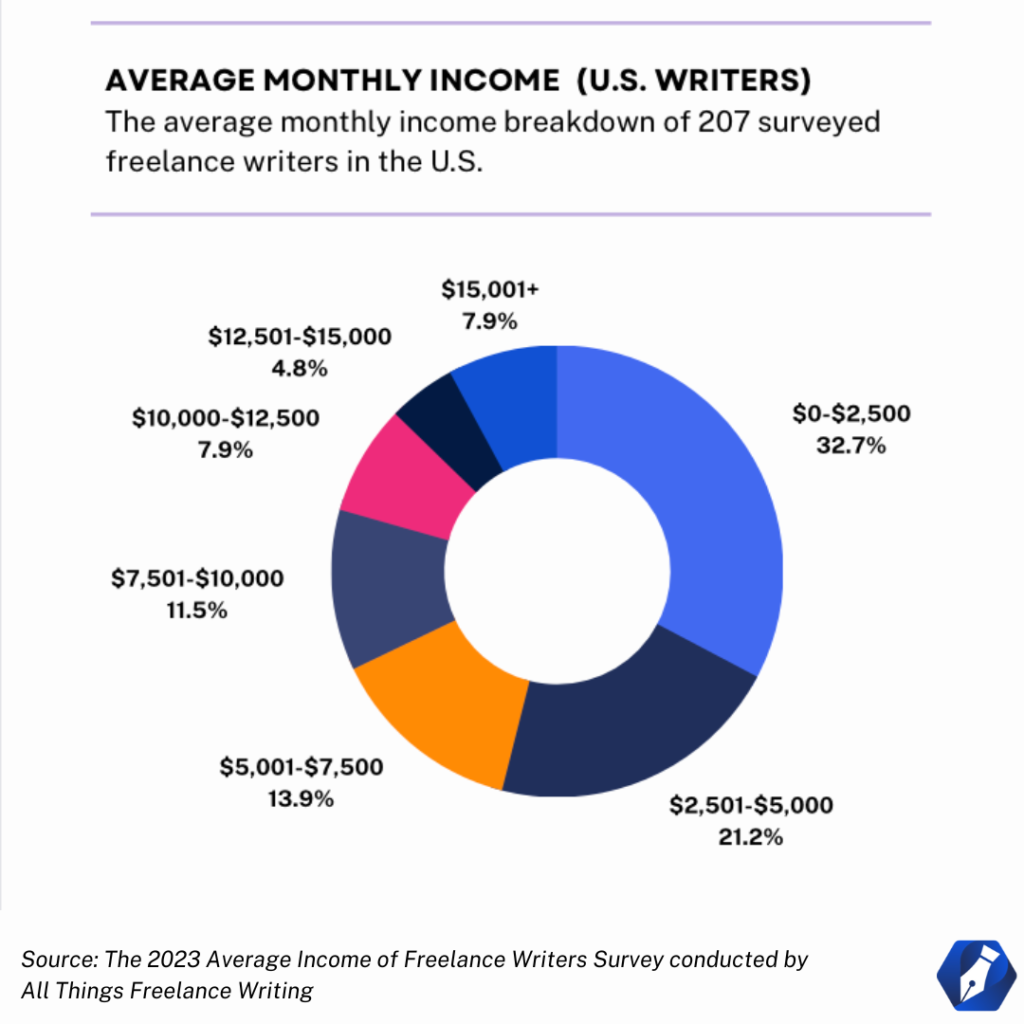
When looking at the results from U.S. writers, the majority (53.9%) said they earn $5,000 or less per month, 25.4% reported earning between $5,001 and $10,000, and 20.6% reported earning $10,001 or more.
Annual freelance writing income stats:
- About 66% of global freelance writers from our survey are earning $60k or less per year, while about 24% are earning more than $90k.
- About 54% of U.S. freelance writers from our survey are earning $60k or less per year, while about 32% are earning more than $90k.
Freelance Writing Charging Methods and Income Impact

Freelance writers charge clients using a variety of methods. But which are most common and how do they affect income? To find out, we asked writers if they charge by the hour, by the word, using a fixed rate, or via another method.
Note: Writers could choose more than one option.
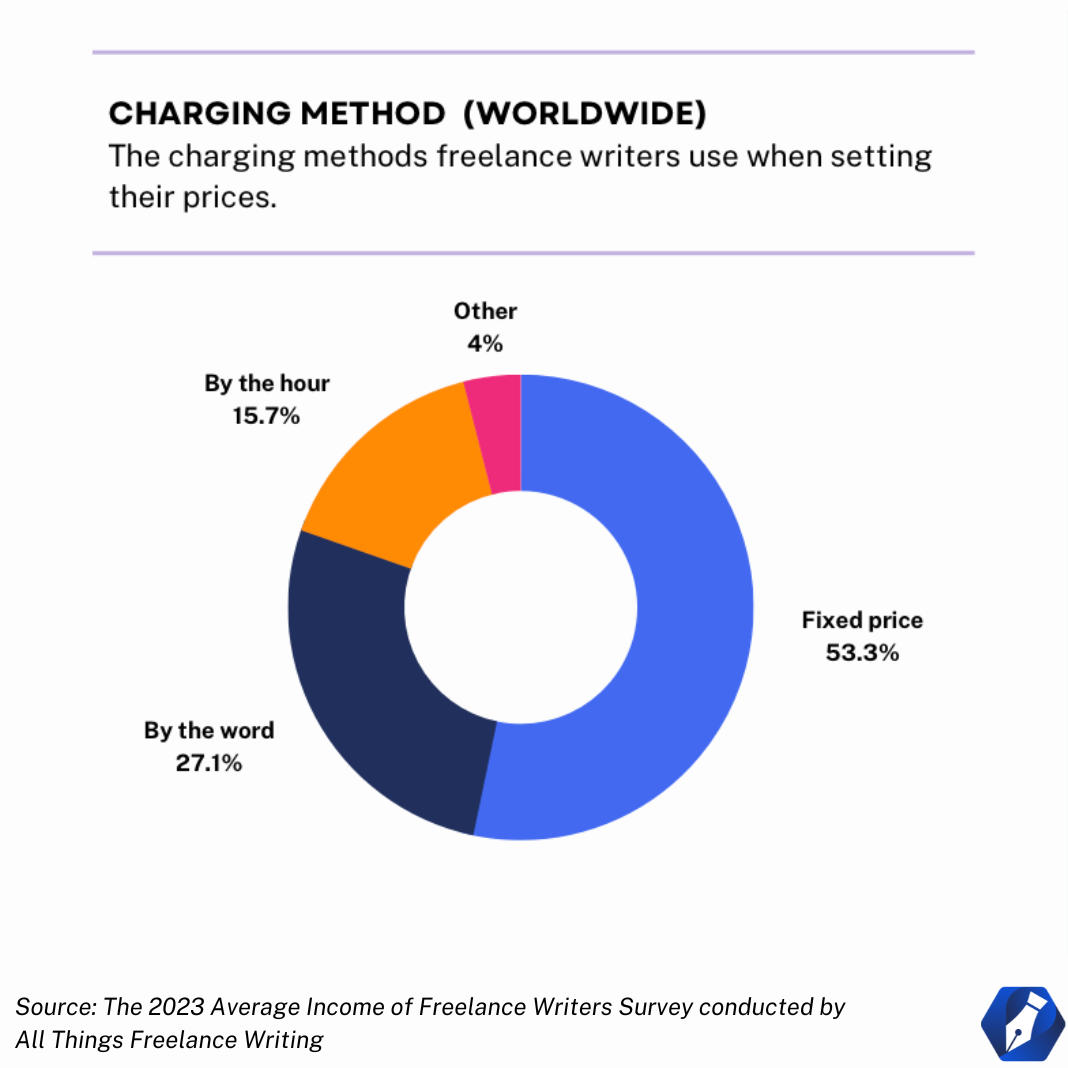
Fixed pricing was by far the most popular choice, with 53.3% of freelance writers citing it as a method they use. Charging by the word was the second most popular method (27.1%) and charging by the hour was the third (15.7%).

The results were pretty similar for U.S. freelance writers. About 55% said they charge using a fixed price, 21% charge by the hour, and 22% charge by the word. The biggest difference from the global results was a larger percentage of U.S. writers charge by the hour.
But does a particular charging method help freelance writers earn more?
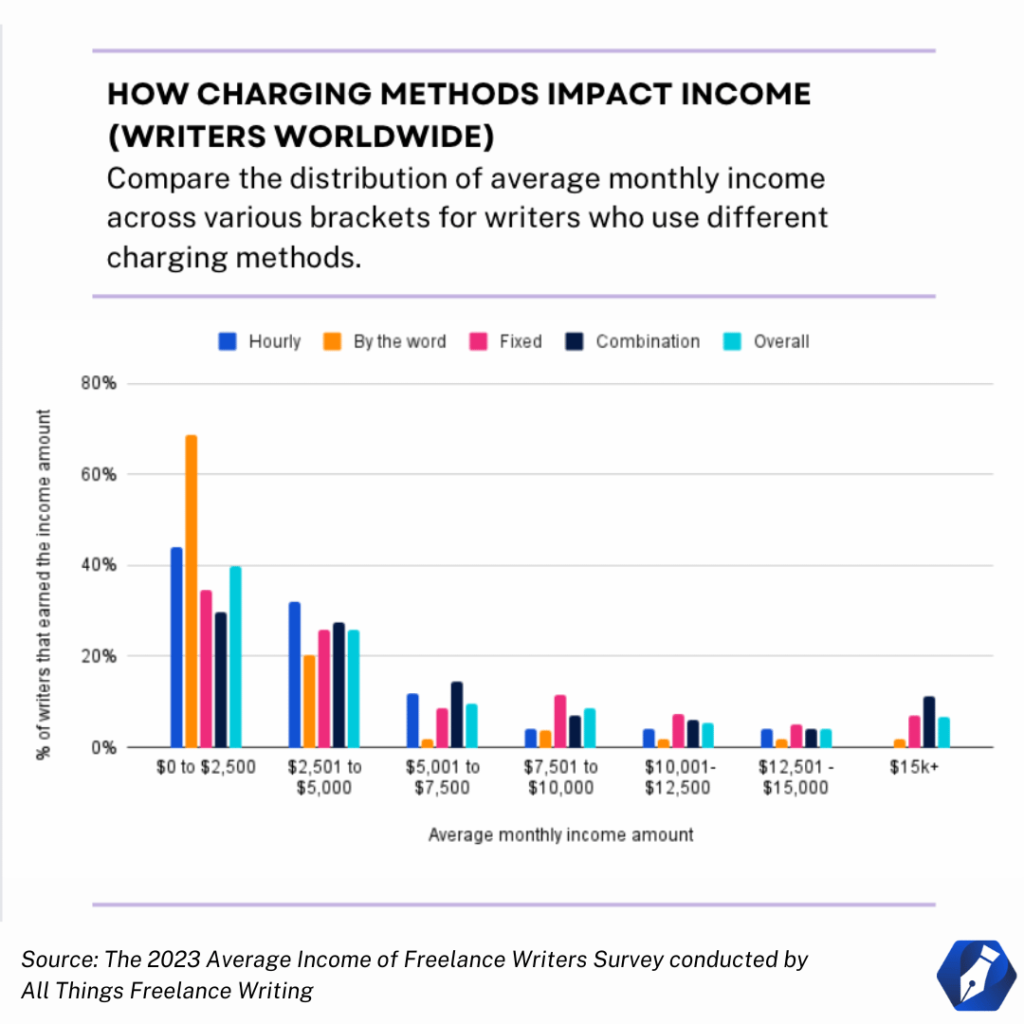
When looking at the worldwide results, those who charge exclusively by the word or hour tend to make less than those who charge using fixed pricing or a combination of methods.

For U.S. writers, those who charge solely by the word or hour had the highest representation in the lowest income bracket ($0 to $2,500). Additionally, those who charge a fixed rate or use a combination of methods had the highest representation in the highest income bracket ($15k+).
In between, the results fluctuated. Compared to the global results, there were more U.S. writers charging by the word and hour in the mid-to-higher-income brackets.
Fixed-Rate Pricing Factors
Fixed-rate pricing can be complex. To better understand what the method entails, we asked writers what they consider when setting fixed prices. Here are the factors that were mentioned most often.
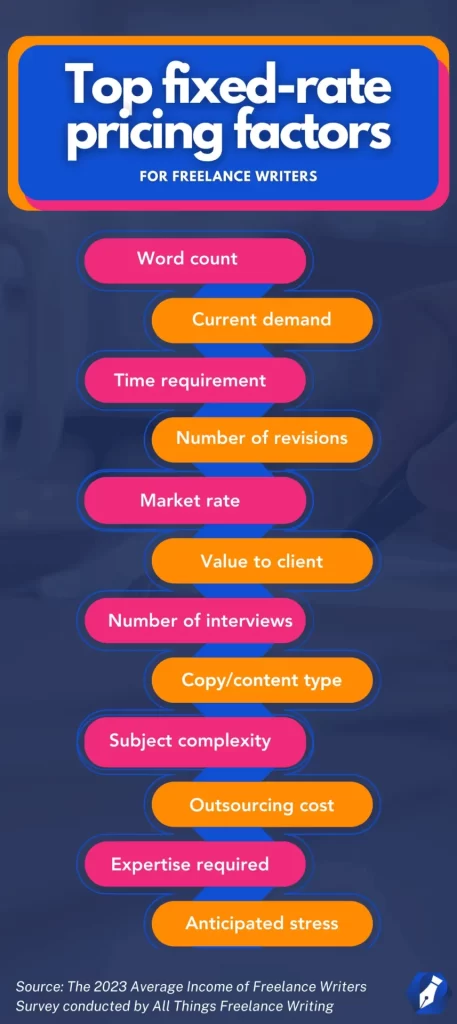
Learn more about the fixed-price factors.
Hourly Rate Pricing of Freelance Writers
Next, let’s take a closer look at the average hourly rates of freelance writers.

When looking at the rates of survey respondents worldwide, 66.5% charge more than $50 per hour. About 22% charge $101 per hour or more.
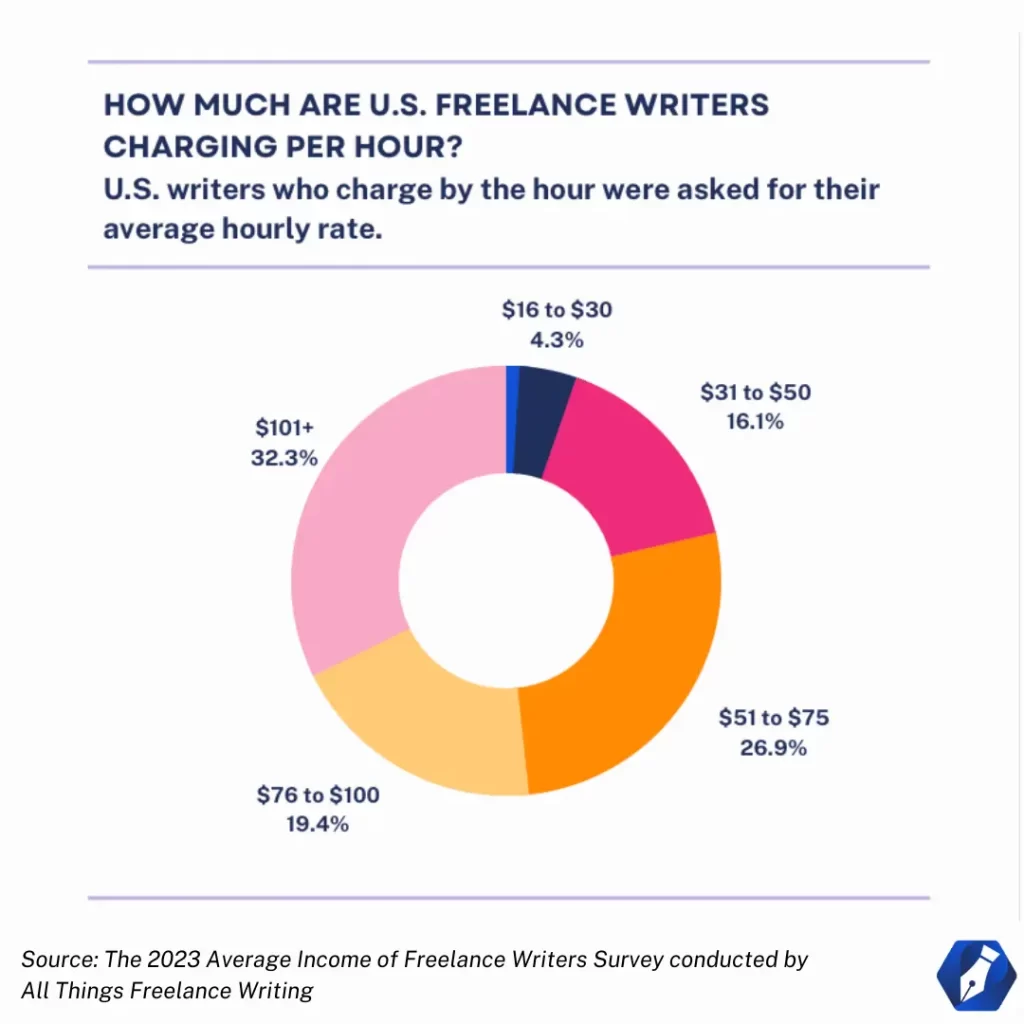
As for U.S. respondents, 78.6% are charging at least $51 per hour, and about 32% charge $101 per hour or more. The majority are earning rates far above the average rate of $22.68 reported by Indeed (based on 218 salaries) or $29.32 reported by ZipRecruiter.
Pay-Per-Word Pricing of Freelance Writers
Now for writers that charge per word. Here’s a look at the average pay-per-word (PPW) rates for all writers and for those in the U.S.

Overall, 32.4% of global freelance writers charge over $0.50 per word. The most common PPW range was $0.16 to $0.30, closely followed by $0.01 to $0.15.

When looking at the average rates of U.S. freelance writers, 48.5% charge over $0.50 per word. The most common PPW range was $0.31 to $0.50, followed by $1.01+ per word.

Unsurprisingly, there’s a correlation between higher rates and higher monthly income. The majority of writers are earning from $0 to $7,500 per month.
However, those charging $0.31 per word or more have a higher representation in the $7,501+ income brackets, while those charging $0.30 or below are nearly always earning $7,500 or less.
Outsourcing Freelance Writing Work and Income Impact

Once freelance writers get their businesses rolling, they often reach a point where they have more work than they can do. In some cases, writers will then subcontract work to others. But how many are taking this route and is it more profitable?

Just 13.6% of freelance writers report outsourcing their work to other writers. The majority (86.4%) said they do all of the work themselves.
But which writers are outsourcing? Here’s a look at the percentage of writers in each income bracket that outsource their work.
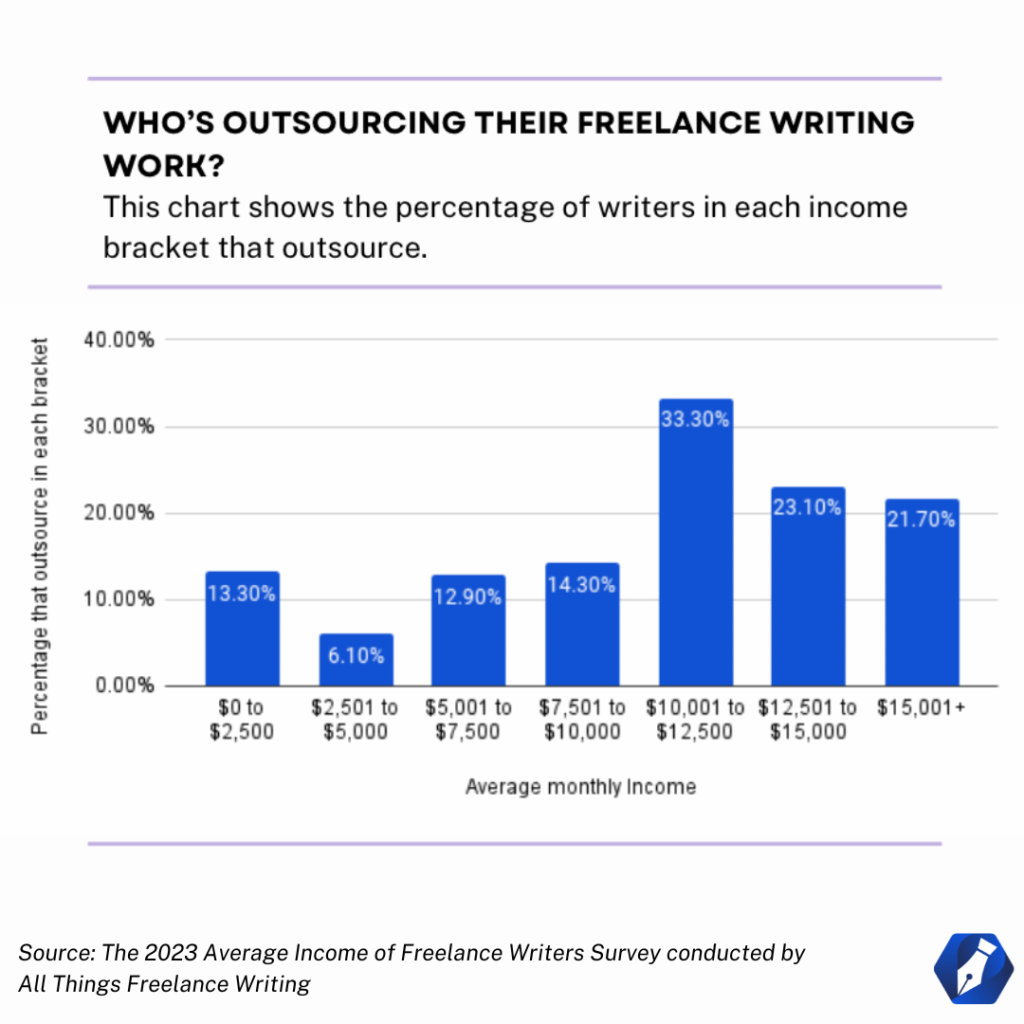
Outsourcing occurred at some level across all of the monthly income brackets, but it was most common for freelance writers earning an average of $10k+ per month. That said, writers who don’t outsource made up the majority in all of the income brackets.
While outsourcing may help to boost revenue, many writers are hitting the higher revenue brackets without it. Higher revenue also doesn’t necessarily mean a higher net income when outsourcing as a percentage of the income goes to paying the hired writers.
Freelance Writing Niches and Income Impact

A freelance writing niche refers to an area of specialization for a freelance writer. In many cases, writers niche down by the industry they serve and/or the writing type they provide.
For example, a writer may specialize in serving B2B SaaS clients and providing email drip sequences. When asked if they had a niche, 76.1% of all of the freelance writers in our survey said yes.
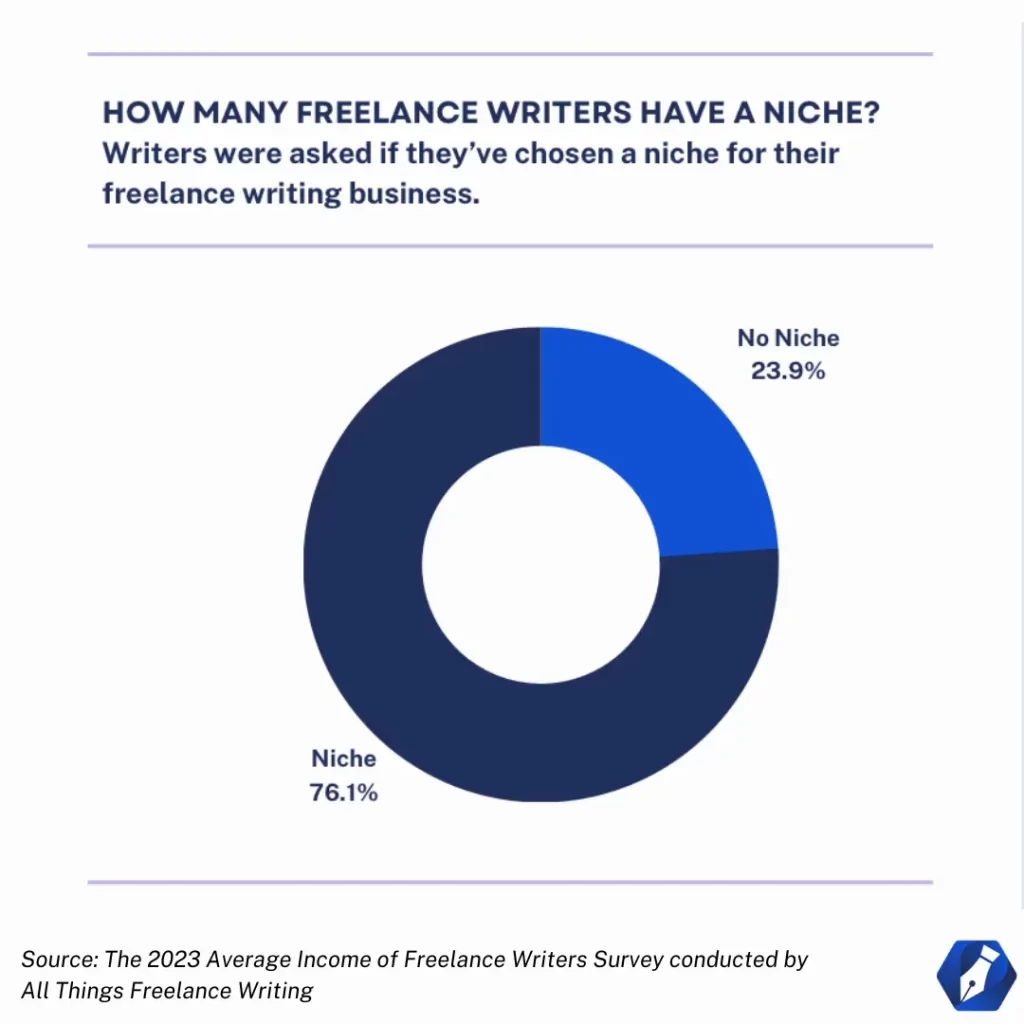
But does niching result in more income?

A higher percentage of the writers who average over $10,000 per month had niches. While just 70% of writers making $0 to $2,500 per month had a niche, 95.5% of those making $15,000 or more had one.

Of the writers surveyed, non-niched-down writers made up the majority of those who earned $2,500 or less per month. Niched and non-niched writers were then neck and neck from $2,500 to $10,000. However, after the $10k mark, a higher percentage of niched-down writers were consistently in the higher income brackets.
Freelance Writing Niches By Industry
All niches are not equal in terms of demand and profitability, and niching down alone doesn’t guarantee an income boost.
Here’s a look at the average monthly income breakdown of freelance writers in the four most popular niches in our survey — tech, health, finance, and B2B SaaS.

Tech and finance writers have a relatively even distribution across the income brackets, meaning writers are earning at all levels. While health writers are earning up to $15k, the majority are earning $10k or less. B2B SaaS has an interesting distribution with a stark divide — about 80% of writers are earning $5k or less, while 20% are earning $15k+.
If you decide to niche down by industry, it’s important to choose a growing sector with demand for writers. These four are great examples.
Freelance Writing Niches by Writing Type
Some writers niche down by writing type, but which writing types are the most popular?
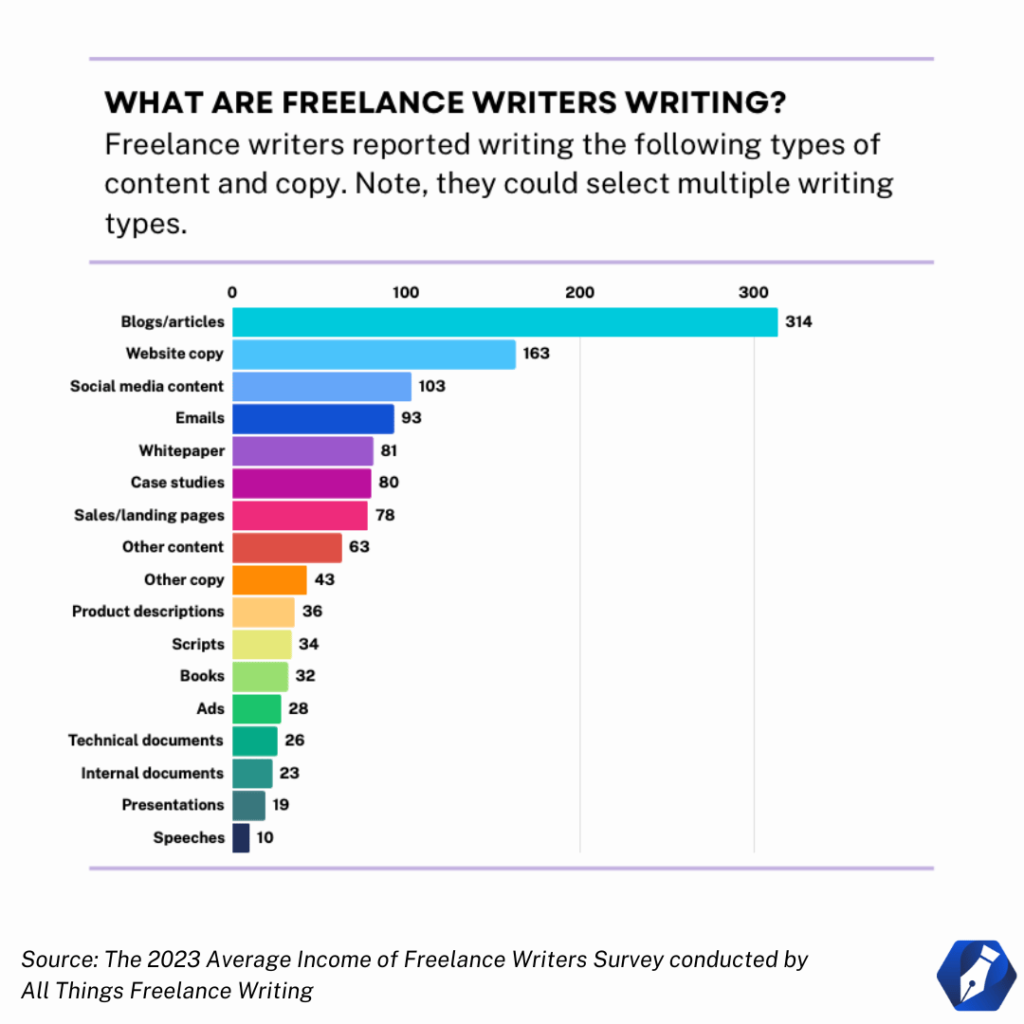
- 92.4% write blog posts/articles
- 47.9% write website copy
- 30.3% write social media content
- 27.4% write emails
- 23.8% write whitepapers

Tip: Looking for writing jobs in a specific niche? Jooble.org curates a list on an ongoing basis. For example, if you’re passionate about science, you can find science writer vacancies. We also share 20-30+ gigs per week across a variety of niches on our job board.
Freelance Writing Payment Schedules and Income Impact
Freelancers vary in terms of when they get paid so we asked writers how they charge clients; 100% before projects, 100% after projects, or 50% before and 50% after.
Note, writers could choose multiple options.
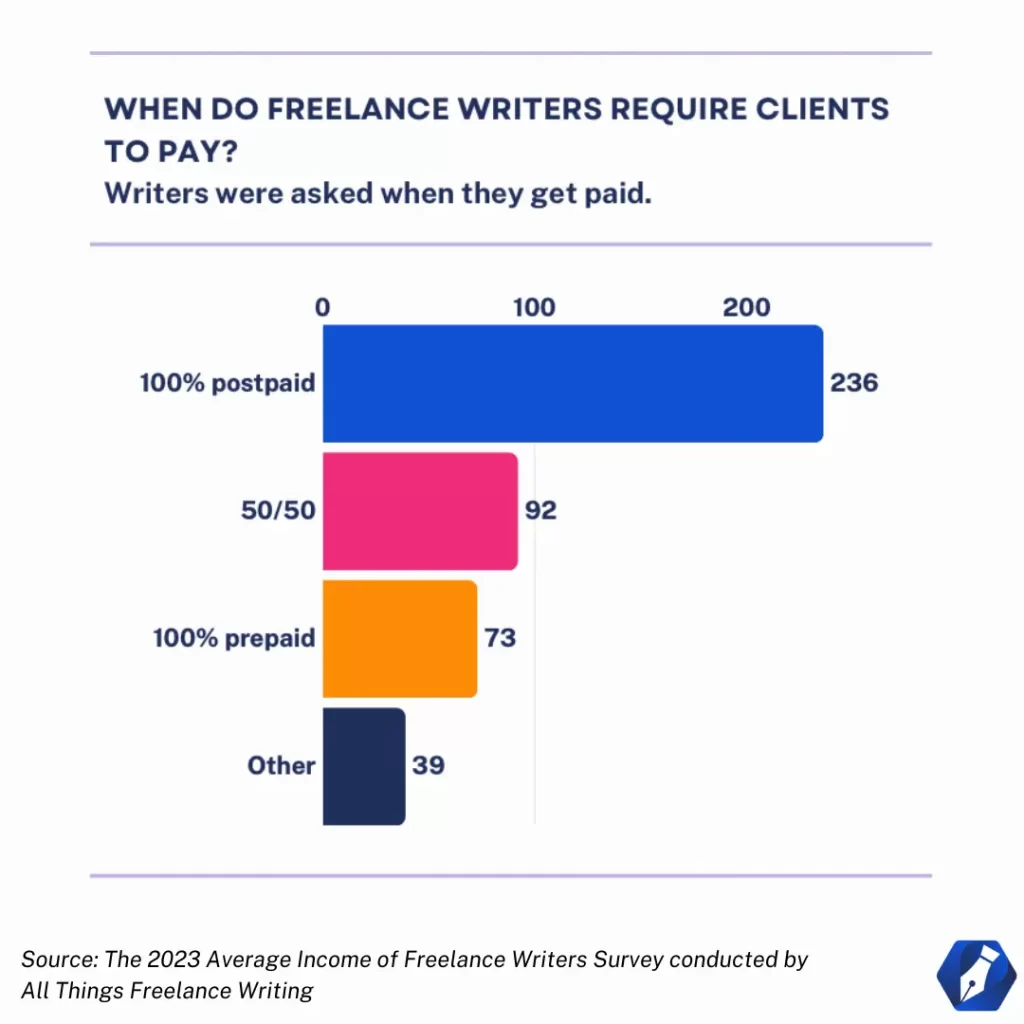
The majority of respondents (69%) get paid in full when the project is complete, 27.1% get paid 50 before/50 after, and about 21.5% get paid upfront.
Let’s look at how payment timing correlates with income.
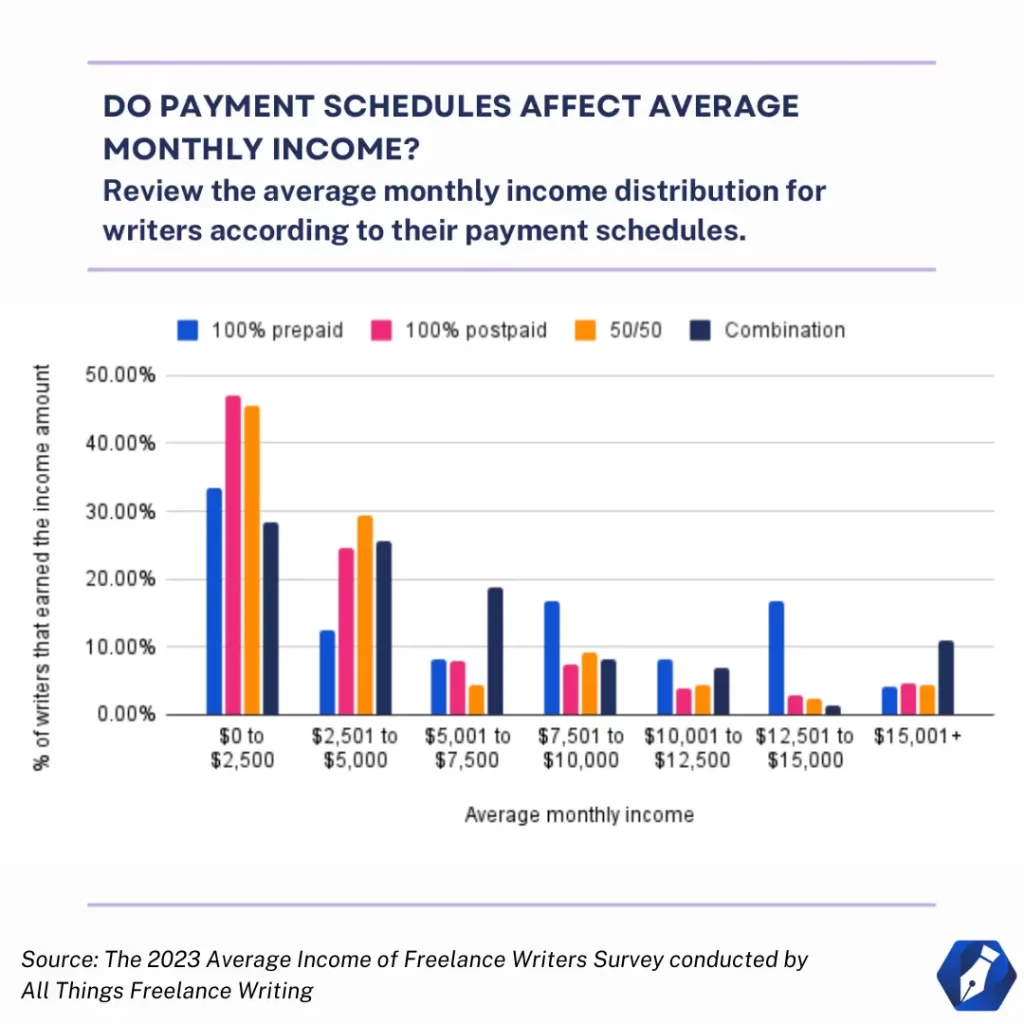
Writers who are 100% postpaid or paid 50/50 have a larger representation in the $0 to $5k income brackets. However, there are writers across all income brackets who were partially or fully postpaid.
Fully prepaid writers were dominant in the brackets ranging from $7.5k to $15k. Further, those paid via a combination of methods had a large representation in the $15k+ income bracket.
Hours Spent Writing and Income Impact

Freelance writers were also asked how much time they spend writing per week. Here’s what they said.

So much for the four-hour workweek! The majority of freelance writers (77.8%) are working between 11 and 40 hours per week. But do more hours worked mean more money?
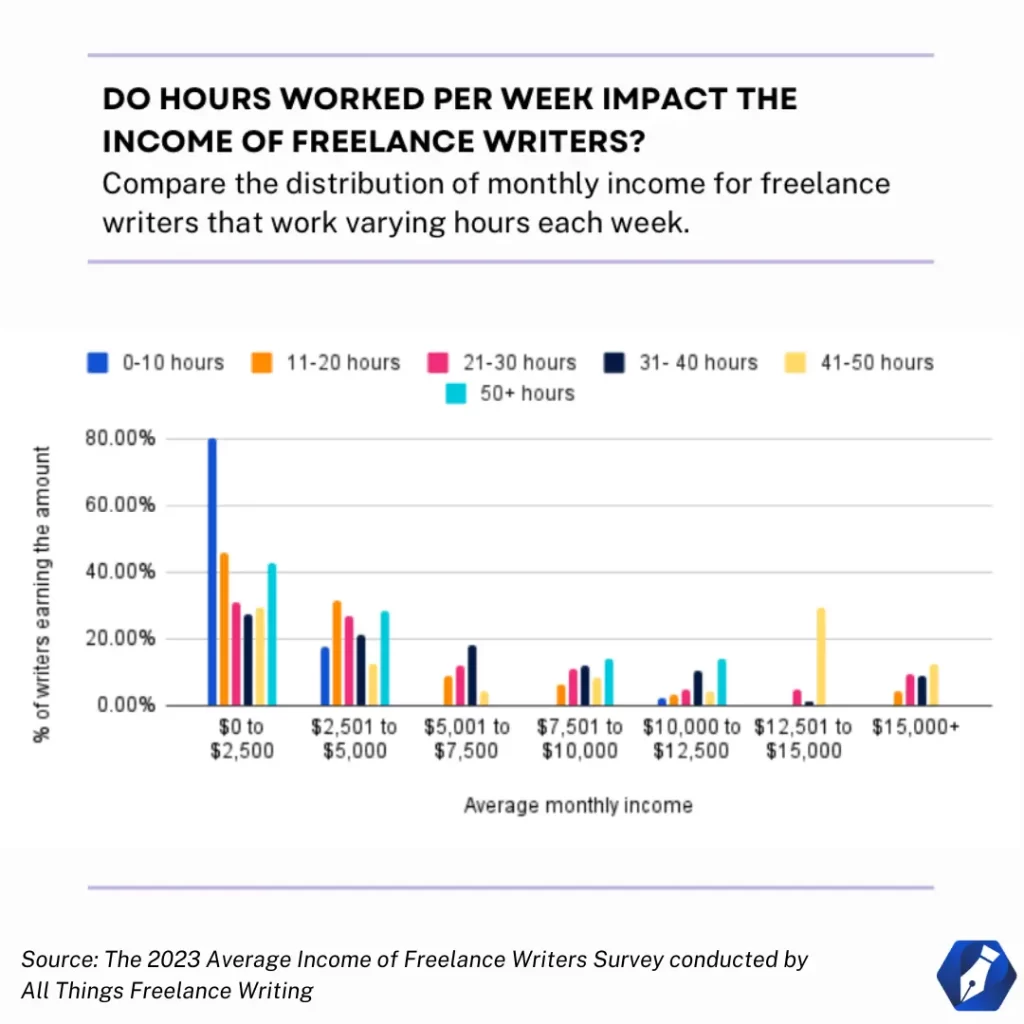
In most cases, more hours did correlate with higher income levels. However, there are a few anomalies. No writers working 50+ hours earned over $12.5k, while writers working fewer hours did. Additionally, the percentage of writers in the lower brackets tended to reduce as hours increased, with the exception of the writers working 50+ hours.
Freelance Writing Experience and Income Impact

There’s no teacher quite like experience. Over time, writers sharpen their skills, improve their business processes, and increase their incomes.
The writers in our survey reported the following experience levels.
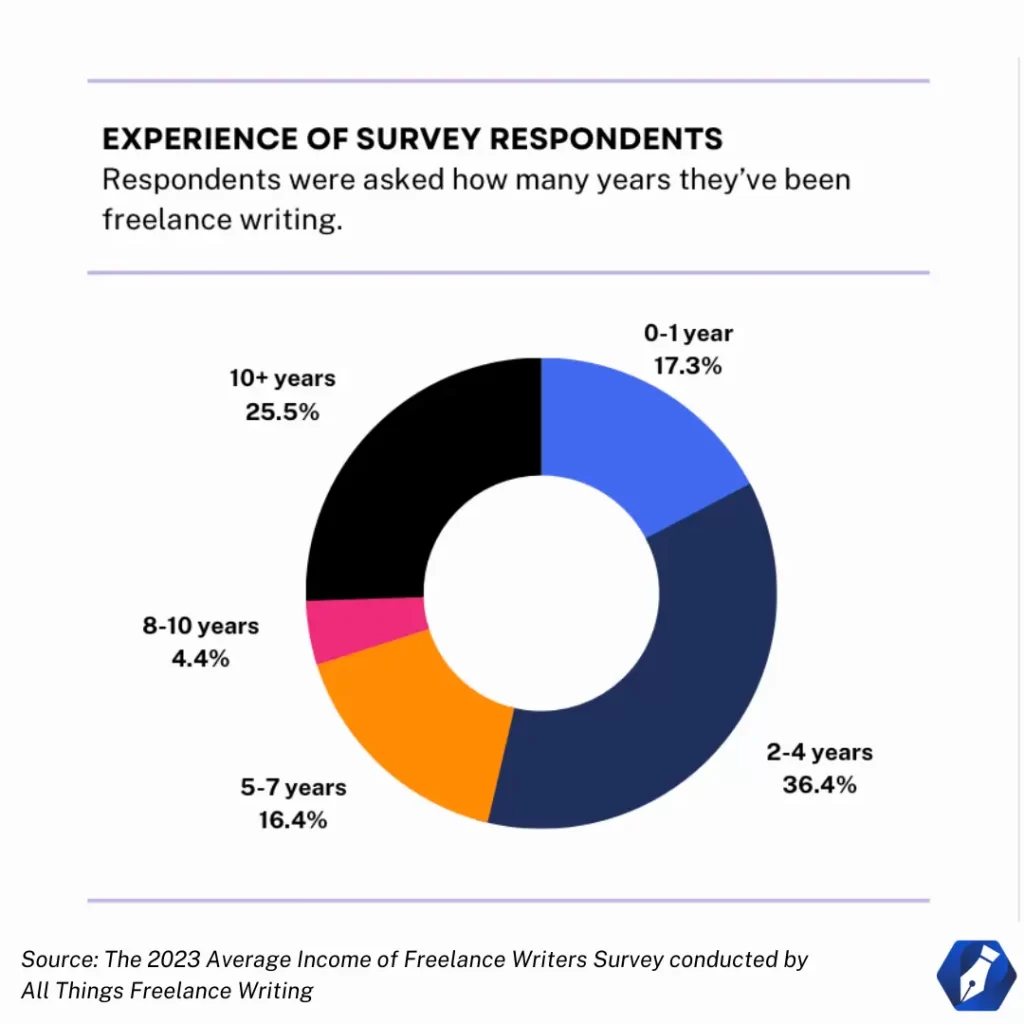
But how does experience translate when it comes to monthly average income?

More experience tends to correlate with higher earnings. The more we learn, the more we earn. That said, there are exceptions in every income bracket. Some writers with 10+ years of experience were earning $2.5k or less, while writers with as little as two years of experience were earning $15k+.
Number of Freelance Writing Clients and Income Impact
Last but not least, let’s talk about client rosters. More specifically, the number of clients freelance writers have and how it impacts income.
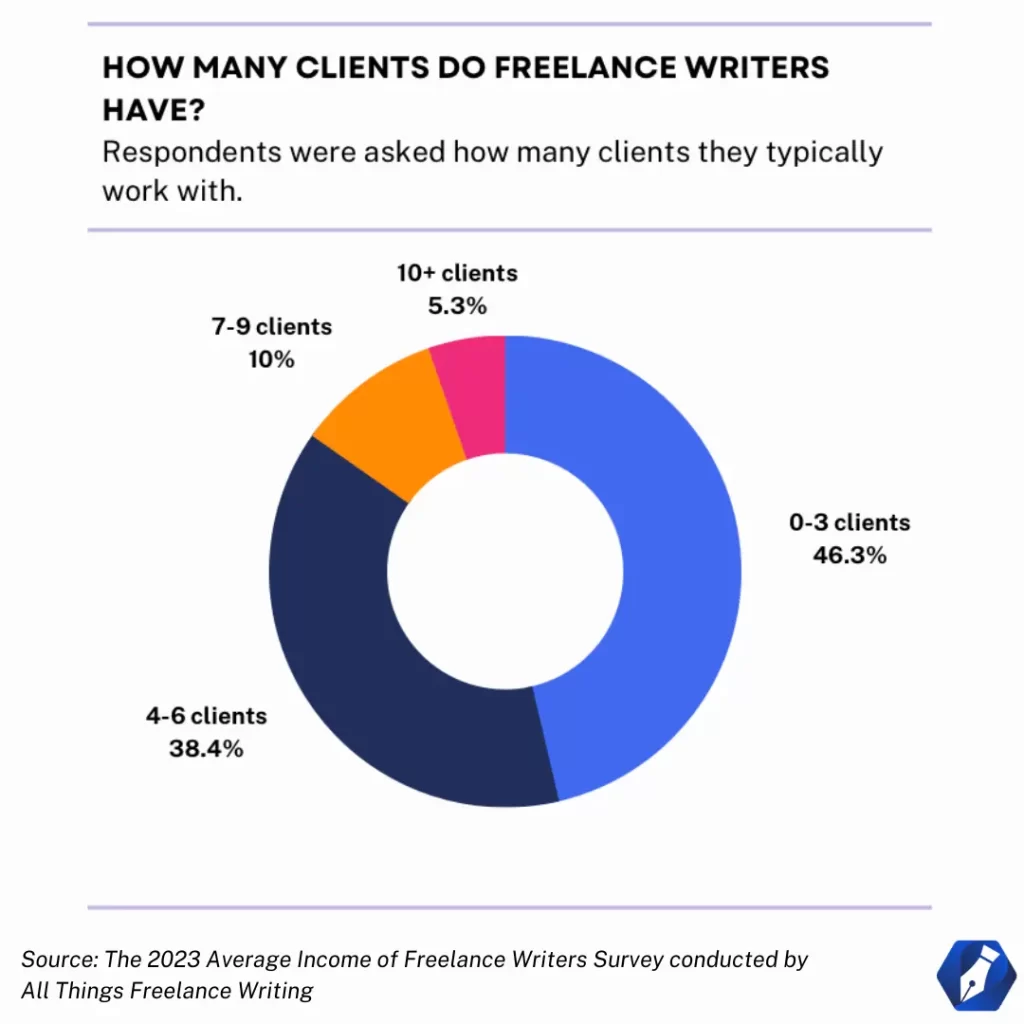
Almost half (46.3%) of the surveyed writers had 0-3 clients, 38.4% had 4-6, and 15.3% had 7 or more.
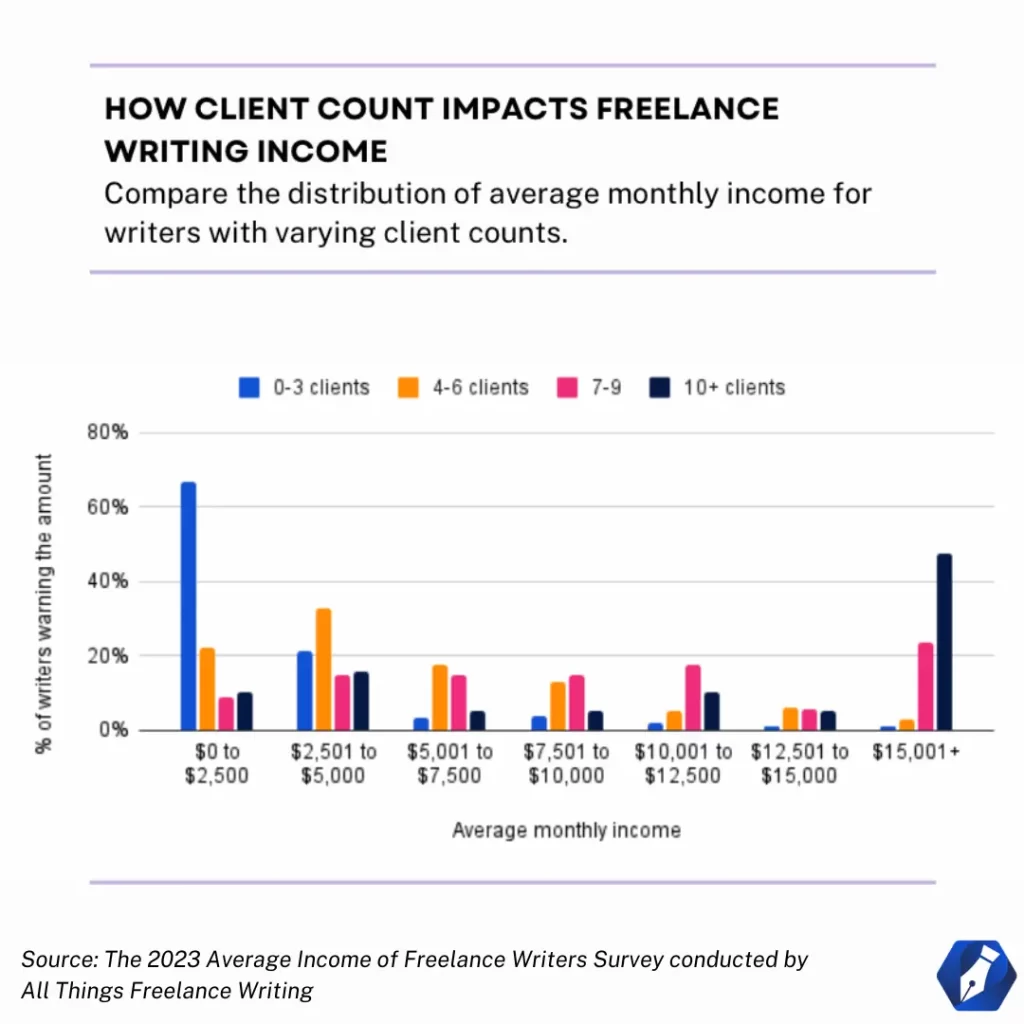
Writers with 0-3 clients had the largest representation in the lower income brackets and dominated the $0 to $2.5K bracket. Writers with 4-6 clients most often made between $0 and $10k.
Writers with 7+ clients had a pretty even spread across all of the income brackets, but spiked in the $15k bracket.
Final Thoughts
Okay, that’s a wrap! It was interesting to see what writers are earning in 2023, as well as how certain practices correlate with higher levels of income, including:
- Charging via fixed pricing or a combination of methods
- Choosing a profitable niche
- Charging upfront
- Upping hours but not overdoing it
- Sticking with your business long-term
- Managing 4+ clients
Another important thing to note is that, while there were clear trends, there were also exceptions in almost every circumstance. Just because something may work for many, doesn’t mean it’s the only way.
We’d love to hear your thoughts and feedback in the comments below. Plus, let us know what you’d like to see added in future reports.
To your success and ideal business!
About the ATFW Average Income of Freelance Writers 2023 Survey

The 2023 Average Income of Freelance Writers survey was performed by All Things Freelance Writing in April of 2023. We asked 346 freelance writers from 31 countries 12 questions about their freelance writing businesses.
Approximately 60% of our respondents were from the United States, 7.3% were from India, 5.5% were from the United Kingdom, 5.5% were from Nigeria, and 4.4% were from Canada.
The remaining 17% (approximately) were from 26 other countries, including Australia, Costa Rica, Colombia, Croatia, Ecuador, England, France, Germany, Indonesia, Italy, Kenya, Luxembourg, Mexico, New Zealand, Norway, Oman, Pakistan, Peru, Philippines, Poland, South Africa, Spain, UAE, Ukraine, Venezuela, and Vietnam.
What are the top fixed-price factors for freelance writers?

Here’s a little more context about each of the top fixed-price factors:
- Word count: The estimated amount of words that will be required for the writing project.
- Current demand: The level of demand a writer is currently receiving for their services and how that compares to the amount the writer can supply.
- Estimated time requirement: The amount of time a writer estimates a piece will take, often based on experience and research.
- Number of revision rounds: The amount of revision rounds that are included in the price.
- Market rate for the service: The going rate range for the writing type on the market.
- Value of the project to the client: The amount of value the project will bring to the client (e.g. sales, revenue, reach, authority, etc.)
- Number of interviews required: If the piece requires interviews, the amount that will be included in the price (and the length/depth of the interviews).
- Type of content or copy: The type of writing and the channel it’ll be published on.
- Subject complexity: The density/complexity of the subject matter.
- Cost of outsourcing (when applicable): When writers outsource, the cost of hiring another writer to complete their portion of the project.
- Level of expertise required: Does the writer have specialized expertise that the piece will require?
- Anticipated level of stress: If a project sounds like it will trigger an undue stress response due to the scope, the client, a deadline, etc., an additional charge may be added.
- Deadline: Rush deliveries can incur extra costs.
11 Key Takeaways: Shareable Stats
- Average Income: 34% of all surveyed writers and 46% of those from the U.S. reported earnings of $5k or more per month.
- Charging Methods: The majority of surveyed freelance writers (53%) charge using a fixed-price method.
- Hourly Rates: 67% of all surveyed writers and 79% of those from the U.S. charge $51 or more per hour.
- Pay-Per-Word (PPW) Rates: The most common PPW ranges were $0.31 to $0.50 in the U.S. and $0.16 to $0.30 for all writers.
- Outsourcing: Just 13.6% of surveyed freelance writers reported outsourcing their work. It was most common for those earning $10k or more per month.
- Niching: 76% of freelance writers said they have a niche. Niching down correlated with higher income.
- Writing types: Almost all freelance writers (92.4%) reported writing blogs and articles as at least one of their services.
- Payment schedules: 69% of the surveyed freelance writers report being 100% post-paid, 21.5% are 100% prepaid, and 27% are 50/50.
- Hours worked: 78% of the freelance writers report working between 11 and 40 hours per week. More hours correlated with higher earnings until the 50+ hour mark.
- Years of experience: More experience tends to correlate with higher earnings. The more we learn, the more we earn!
- Number of clients: Almost half (46.3%) of the surveyed writers reported having 0-3 clients, 38.4% reported 4-6, and 15.3% had 7 or more.



